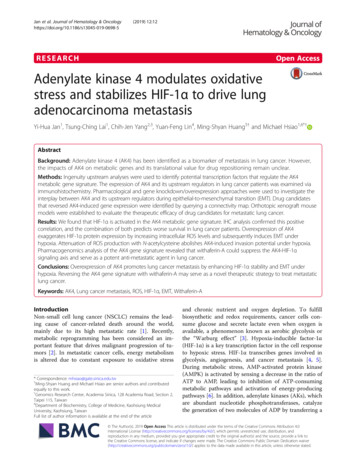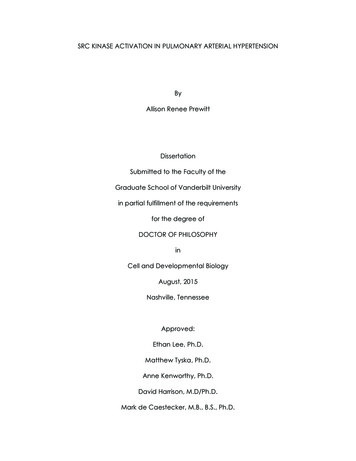
Transcription
Jan et al. Journal of Hematology & 2019) 12:12RESEARCHOpen AccessAdenylate kinase 4 modulates oxidativestress and stabilizes HIF-1α to drive lungadenocarcinoma metastasisYi-Hua Jan1, Tsung-Ching Lai1, Chih-Jen Yang2,3, Yuan-Feng Lin4, Ming-Shyan Huang5† and Michael Hsiao1,6*†AbstractBackground: Adenylate kinase 4 (AK4) has been identified as a biomarker of metastasis in lung cancer. However,the impacts of AK4 on metabolic genes and its translational value for drug repositioning remain unclear.Methods: Ingenuity upstream analyses were used to identify potential transcription factors that regulate the AK4metabolic gene signature. The expression of AK4 and its upstream regulators in lung cancer patients was examined viaimmunohistochemistry. Pharmacological and gene knockdown/overexpression approaches were used to investigate theinterplay between AK4 and its upstream regulators during epithelial-to-mesenchymal transition (EMT). Drug candidatesthat reversed AK4-induced gene expression were identified by querying a connectivity map. Orthotopic xenograft mousemodels were established to evaluate the therapeutic efficacy of drug candidates for metastatic lung cancer.Results: We found that HIF-1α is activated in the AK4 metabolic gene signature. IHC analysis confirmed this positivecorrelation, and the combination of both predicts worse survival in lung cancer patients. Overexpression of AK4exaggerates HIF-1α protein expression by increasing intracellular ROS levels and subsequently induces EMT underhypoxia. Attenuation of ROS production with N-acetylcysteine abolishes AK4-induced invasion potential under hypoxia.Pharmacogenomics analysis of the AK4 gene signature revealed that withaferin-A could suppress the AK4-HIF-1αsignaling axis and serve as a potent anti-metastatic agent in lung cancer.Conclusions: Overexpression of AK4 promotes lung cancer metastasis by enhancing HIF-1α stability and EMT underhypoxia. Reversing the AK4 gene signature with withaferin-A may serve as a novel therapeutic strategy to treat metastaticlung cancer.Keywords: AK4, Lung cancer metastasis, ROS, HIF-1α, EMT, Withaferin-AIntroductionNon-small cell lung cancer (NSCLC) remains the leading cause of cancer-related death around the world,mainly due to its high metastatic rate [1]. Recently,metabolic reprogramming has been considered an important feature that drives malignant progression of tumors [2]. In metastatic cancer cells, energy metabolismis altered due to constant exposure to oxidative stress* Correspondence: mhsiao@gate.sinica.edu.tw†Ming-Shyan Huang and Michael Hsiao are senior authors and contributedequally to this work.1Genomics Research Center, Academia Sinica, 128 Academia Road, Section 2,Taipei 115, Taiwan6Department of Biochemistry, College of Medicine, Kaohsiung MedicalUniversity, Kaohsiung, TaiwanFull list of author information is available at the end of the articleand chronic nutrient and oxygen depletion. To fulfillbiosynthetic and redox requirements, cancer cells consume glucose and secrete lactate even when oxygen isavailable, a phenomenon known as aerobic glycolysis orthe “Warburg effect” [3]. Hypoxia-inducible factor-1α(HIF-1α) is a key transcription factor in the cell responseto hypoxic stress. HIF-1α transcribes genes involved inglycolysis, angiogenesis, and cancer metastasis [4, 5].During metabolic stress, AMP-activated protein kinase(AMPK) is activated by sensing a decrease in the ratio ofATP to AMP, leading to inhibition of ATP-consumingmetabolic pathways and activation of energy-producingpathways [6]. In addition, adenylate kinases (AKs), whichare abundant nucleotide phosphotransferases, catalyzethe generation of two molecules of ADP by transferring a The Author(s). 2019 Open Access This article is distributed under the terms of the Creative Commons Attribution 4.0International License (http://creativecommons.org/licenses/by/4.0/), which permits unrestricted use, distribution, andreproduction in any medium, provided you give appropriate credit to the original author(s) and the source, provide a link tothe Creative Commons license, and indicate if changes were made. The Creative Commons Public Domain Dedication o/1.0/) applies to the data made available in this article, unless otherwise stated.
Jan et al. Journal of Hematology & Oncology(2019) 12:12phosphate group from one molecule of ATP or GTP toAMP. The main role of AKs is to balance cellular adeninenucleotide composition to maintain energy homeostasis[7]. However, the link between energy homeostasis andcancer progression has not been clearly elucidated.Adenylate kinase 4 (AK4) is localized in the mitochondrial matrix [8] and has been shown to physically bindto mitochondrial ADP/ATP translocase (ANT) as astress-responsive protein to maintain cell survival [9].Moreover, several genomic and proteomic studies haveshown that AK4 expression fluctuates under cellularstress conditions [10–13]. Significantly increased AK4protein levels have been detected during development,in cultured cells exposed to hypoxia and in an animalmodel of amyotrophic lateral sclerosis [9, 14–16]. Moreover, Lanning et al. showed that silencing of AK4elevates the cellular ATP level up to 25% and concurrently increases the ADP/ATP ratio, which activatesAMPK signaling [17]. Previously, we identified AK4 as alung cancer progression marker by assessing the correlation between AK4 levels and clinicopathological features [18]. However, how AK4-induced metabolicchanges may affect cancer progression remains unclear.Here, we aimed to investigate the impact of AK4 expression on metabolic genes by analyzing lung cancermicroarray datasets and decipher the functional consequences on lung cancer metastasis. We found that HIF-1αactivity is significantly activated in lung adenocarcinomapatients with an AK4 metabolic gene signature. Overexpression of AK4 shifts metabolism toward aerobic glycolysisand increases the levels of intracellular reactive oxygen species (ROS), which subsequently stabilizes HIF-1α proteinand promotes epithelial-to-mesenchymal transition (EMT)in lung cancer cells in a HIF-1α-dependent manner. Thesefindings represent a novel vicious cycle between AK4 andHIF-1α in response to hypoxic stress during lung cancerprogression and highlight the therapeutic opportunity oftargeting the AK4-HIF-1α axis in NSCLC.Materials and methodsSpecimensClinical non-small cell lung cancer (NSCLC) samples werecollected with IRB approval (KMUHIRB-E(I)-20160099)from the Kaohsiung Medical University Hospital and werefixed in formalin and embedded in paraffin before beingarchived. The archived specimens, with follow-up timesup to 200 months, were used for immunohistochemicalstaining. The histologic diagnosis was made according tothe World Health Organization (WHO) classificationguidelines for lung cancer. The pathological diagnosis oftumor size, local invasion, lymph node involvement, distalmetastasis, and final disease stage were determined according to the American Joint Committee on Cancer(AJCC) TNM classification of lung cancer.Page 2 of 14Tissue microarray and immunohistochemical stainingRepresentative 1-mm-diameter cores from each tumorsample were selected by matching histology from original hematoxylin and eosin (H&E)-stained slides, andthe histopathologic diagnosis of all samples was reviewedand confirmed by pathologists. IHC staining was performed using an automated immunostainer (VentanaDiscovery XT autostainer, Ventana, USA) with a 30-minheat-induced antigen retrieval procedure in TRIS-EDTAbuffer. Protein expression was visualized using a 3,3′-diaminobenzidine (DAB) peroxidase substrate kit (Ventana, USA). The following antibodies were used todetect AK4, HIF-1α, E-cadherin, and pimonidazole intissues: AK4 (Genetex, 1:200), HIF-1α (Cell Signaling,1:100), E-cadherin (Cell Signaling, 1:100), and pimonidazole (Hypoxyprobe, INC).Histology and IHC staining interpretationThe IHC staining results were assessed and scored independently by two pathologists who were blinded to thepatient clinical outcomes. A consensus decision wasmade when there was an interobserver discrepancy. Forscoring, both intensity and percentage of protein expression were recorded. The staining intensity was scored asfollows: 0, no staining; 1 , weak staining; 2 , moderatestaining; 3 , strong staining. The extent of staining wasfurther divided into two groups according to 25% oftumor cells with staining. A high IHC expression levelwas defined as a staining intensity of 2 or 3 in over25% of tumor cells.Microarray data analysisThe raw intensities of AK4 overexpression in CL1-0 cells(GSE37903) and lung adenocarcinoma patient datasets(GSE31210) were normalized by robust multichip analysis (RMA) using GeneSpring GX11 (Agilent Technologies). AK4-associated gene signatures were identified bycalculating the Pearson correlation coefficient betweenAK4 expression and each coding gene and ranked according to their correlation coefficient to AK4 expression. After applying a Pearson correlation coefficient of 0.3 as a threshold, the AK4 metabolic gene signaturewas identified by selecting genes with enzyme or transporter annotations. Next, gene set enrichment analysis(GSEA) was performed to rank the probes and analyzegene set enrichment using c2.all.v5.1.symbols.gmt [curated] or c2.cp.kegg.v5.1.symbols.gmt [curated] gene setsas a backend database (http://www.broadinstitute.org/gsea). P values less than 0.05 and FDRs less than 25%were considered to indicate significant enrichment.The activation or inhibition status of upstream regulators in the AK4 metabolic gene signature was predictedusing IPA Upstream Regulator Analysis (IngenuitySystems, http://www.ingenuity.com), and the calculated
Jan et al. Journal of Hematology & Oncology(2019) 12:12Page 3 of 14z scores can reflect the overall activation state of theregulator ( 0: inhibited, 0: activated). In practice, a zscore of more than 2 or less than 2 can be consideredsignificant activation or inhibition, respectively.Louis, MO). ATP colorimetric assay, glucose colorimetricassay, and lactate colorimetric assay kits were purchasedfrom BioVision (Milpitas, CA). CellROX Deep Red Reagentwas purchased from Invitrogen.Cell linesCycloheximide assayThe human lung adenocarcinoma cell lines H1355, PC9,H358, H928, CL1-0 CL1-1, CL1-3, and CL1-5 and squamous cell carcinoma cell lines H157 and H520 weremaintained in RPMI 1640 medium (Invitrogen) supplemented with 10% fetal bovine serum (FBS). Human lungadenocarcinoma cell lines (A549, PC13, and PC14) andlarge cell carcinoma H1299 cells were grown in DMEM(Invitrogen) containing 10% FBS. All cells were keptunder a humidified atmosphere containing 5% CO2 at37 C. CL1-0, CL1-1, CL1-3, and CL1-5 cell lines wereestablished by Chu et al. at National Taiwan UniversityHospital and displayed progressively increased invasiveness, while PC13 and PC14 cell lines were derived fromTokyo National Cancer Centre Hospital. Other lungcancer cell lines (A549, H1355, H358, H928, H520,H157, H460, and H1299) were obtained from AmericanType Culture Collection.Cells were plated in 6-well plates and treated with cycloheximide (CHX) at a concentration of 50 μg/mL for 24h. Cells were then exposed to hypoxia for 6 h to stabilizeHIF-1α protein and then switched to normoxic conditions. Protein lysates were harvested at 20-min intervalsunder normoxic conditions.Lentiviral shRNA and expression vectorsGIPZ Lentiviral AK4 (AK3L1) shRNA and HIF1A shRNAconstructs, which carry the puromycin resistance geneand enhanced green fluorescent protein (EGFP), werepurchased from Open Biosystems. Lentiviruses weregenerated by transfecting 293 T cells with the shRNAexpression vector and pMD2.G and pDeltaR8.9 using thecalcium phosphate precipitation method. Virus-containingsupernatants were collected, titrated, and used to infectcells using 8 μg/mL polybrene. Infected cells were selectedusing 2 μg/mL puromycin. For expression of AK4,full-length AK4 cDNA was cloned into a pLenti6.3 lentiviral vector (Invitrogen). AK4-expressing cell lines wereestablished by infecting cells with the pLenti6.3-AK4 viruses generated by transfection of 293 T cells with pLenti6.3AK4, pMD2.G, and pDeltaR8.91. Cells were then selectedin 5 μg/mL blasticidin.Western blot analysisThe following antibodies were used in western blot analyses: anti-AK4 (Genetex, 1:2000), anti-HIF-1α (CellSignaling, 1:1000), anti-hydroxylated HIF-1α (Cell Signaling, 1:1000), anti-E-cadherin (BD Bioscience, 1:1000),anti-vimentin (Sigma, 1:2000), anti-Snail (Cell Signaling,1:1000), and anti-α-tubulin (Sigma-Aldrich, 1:5000)antibodies.Reagent and chemicalsProscillaridin, ouabain, digitoxigenin, digoxin, withaferin-A,and lanatoside-C were purchased from Sigma-Aldrich (St.ATP measurementCells were grown in a 6-well plate overnight, and themedium was refreshed with complete medium. After 24h, a cell pellet was collected, and the amount of ATPwas quantified using an ATP colorimetric assay kit (BioVision) according to the manufacturer’s protocol.Glucose consumption assayCells were grown in a 6-well plate overnight, and themedium was refreshed with complete medium. After 24h, the spent medium was collected, and the amount ofglucose was quantified using a glucose colorimetric assaykit (BioVision) according to the manufacturer’s protocol.Lactate production assayCells were grown in a 6-well plate overnight, and themedium was refreshed with complete medium. After24 h, the spent medium was collected, and theamount of lactate was quantified using a lactate colorimetric assay kit (BioVision) according to the manufacturer’s protocol.ROS measurementROS levels were quantified using CellROX Deep Red Reagent (Invitrogen). Briefly, cells were seeded in a 96-wellplate (2000 cells/well) and washed with PBS. Cells werethen incubated with 5 μM CellROX for 30 min at 37 Cand stained with DAPI. Intracellular ROS were measured using a fluorescence plate reader at absorption/emission wavelengths of 644/665 nm.Invasion assayPolycarbonate filters were coated with human fibronectin on the lower side and Matrigel on the upper side.Medium containing 10% FCS was added to each well ofthe lower compartment of the chamber. Cells were suspended in serum-free medium containing 0.1% bovineserum albumin and loaded into each well of the upperchamber. After 16 h, cells were fixed with methanol andthen stained with Giemsa. Cells that invaded to thelower side of the membrane were counted under a light
Jan et al. Journal of Hematology & Oncology(2019) 12:12microscope ( 200, ten random fields in each well). Allexperiments were performed in quadruplicate.Animal studiesAll animal experiments were conducted according to protocols approved by the Academia Sinica Institutional Animal Care and Unitization Committee. Age-matchedNOD-SCID Gamma (NSG) mice (6–8 weeks old) wereused to construct xenograft models. For the subcutaneousxenograft model, cells were subcutaneously injected intothe flanks of NSG mice at a concentration of 1 106 cellsin 100 μL of PBS. Tumor volumes were measured weeklyfor 4 weeks. At the endpoint, mice were intravenouslyinjected with Hypoxyprobe (Hypoxyprobe, Inc) solution ata dosage of 60 mg/kg body weight and tumors were removed and analyzed for hypoxic necrosis using immunostaining of pimonidazole adducts in tissues. Slides weredigitally scanned using ScanScope AT (Aperio Technologies Inc.). Quantification of hypoxic and non-hypoxic areasin pimonidazole-stained slides was performed using Definiens’ Tissue Studio software (Definiens Inc.). For the orthotopic xenograft model of lung cancer metastasis, 1 105CL1-0 Vec cells, CL1-0 AK4 cells, or A549-GL cells (established by infecting cells with EF1 promoter-driven firefly luciferase viruses and IRES-driven EGFR viruses) weresuspended in 10 μl of PBS/Matrigel mixture (1:1) andinjected into the left lung of NSG mice (n 6 per group).Mice from the withaferin-A treatment group were administered 1 mg/kg body weight or 4 mg/kg body weightwithaferin-A in 100 μL of PBS three times per week via i.p.injection. Control mice were injected with 100 μL of vehiclePBS containing less than 10% DMSO. Four weeks postinjection, mice were sacrificed, and metastatic liver noduleswere counted by gross examination. H&E staining was performed to confirm the histology of metastatic nodules.Statistical analysisStatistical analyses were performed using SPSS 17.0 software(SPSS, USA). The correlation between AK4 and HIF-1α expression determined via IHC was assessed using Spearman’srank correlation analysis. Estimates of survival rates wereobtained using the Kaplan-Meier method and comparedwith a log-rank test. For all analyses, a P value 0.05 wasconsidered statistically significant. All observations wereconfirmed in at least three independent experiments. Theresults are presented as the mean SD. We used two-tailed,unpaired Student’s t tests for all pairwise comparisons.ResultsThe transcription factor HIF-1α is active in the AK4metabolic gene signature in lung adenocarcinomapatientsTo identify the AK4 metabolic gene signature, we analyzed a lung cancer dataset (GSE31210) that containedPage 4 of 14microarray data from 246 stage I/II lung adenocarcinoma patients. We first calculated the Pearson correlationcoefficient between AK4 expression and each codinggene and ranked the genes according to their correlationcoefficient to AK4 expression. We then determined theAK4 metabolic gene signature by selecting genes annotated with enzyme or transporter and applying 0.3Pearson correlation coefficient as the cutoff threshold.By this means, we identified 1501 probes that were significantly associated with AK4 expression in lung adenocarcinoma patients (Fig. 1a). KEGG pathway analysisfurther revealed top 20 enriched metabolic pathways inthe AK4 metabolic gene signature (Fig. 1b). Next, wesubjected the AK4 metabolic gene signature to gene setenrichment analysis (GSEA). Interestingly, the GSEA results showed that gene sets categorized as hypoxia response, HIF1A target, glucose metabolism, and lungcancer prognostic genes were significantly enriched inthe AK4 metabolic gene signature (Fig. 1c). Furthermore,ingenuity upstream regulator analysis showed thatHIF-1α was ranked as the top activated transcriptionfactor, with an activation z score of 4.3 (Fig. 1d, left). Aheatmap illustrated both direct and indirect HIF1α-regulated genes that were positively or negatively correlated with AK4 expression (Fig. 1d, right). KaplanMeier survival analysis showed that high expression ofthe AK4-HIF-1α signature in patients was significantlyassociated with worse overall and relapse-free survivalcompared with low levels of the AK4-HIF-1α signature(Fig. 1e). Meanwhile, we also identified the consensusAK4 metabolic gene signature between the GSE31210lung adenocarcinoma dataset and TCGA LUAD datasetand found that HIF-1α was again significantly activated,with an activation z score of 4.098 (Additional file 1:Figure S1).Combined AK4 and HIF-1α expression predicts a worseprognosis compared with HIF-1 α alone in NSCLC patientsTo validate the correlation between AK4 and HIF-1α inclinical specimens, we assessed their expression in 100NSCLC patients via immunohistochemistry (IHC).Figure 2a shows the scoring criteria for quantifying theexpression of AK4 and HIF-1α via immunoreactivity in serial sections. Spearman correlation analysis of the IHCresults showed a significant positive correlation between AK4 and HIF-1α (Fig. 2b, Spearman’s rho 0.457, P 1.79 10 6). The associations among AK4IHC expression, HIF-1α IHC expression, and clinicopathological characteristics including age, gender,smoking history, tumor histology, TNM stage, pathological stage, and tumor recurrence status are summarized in Additional file 1: Table S1. Chi-squareanalysis showed high expression of AK4 and HIF-1αwas significantly asso
GIPZ Lentiviral AK4 (AK3L1) shRNA and HIF1A shRNA constructs, which carry the puromycin resistance gene and enhanced green fluorescent protein (EGFP), were purchased from Open Biosystems. Lentiviruses were generated by transfecting 293T cells with the shRNA-expression vector and pMD2.G and











